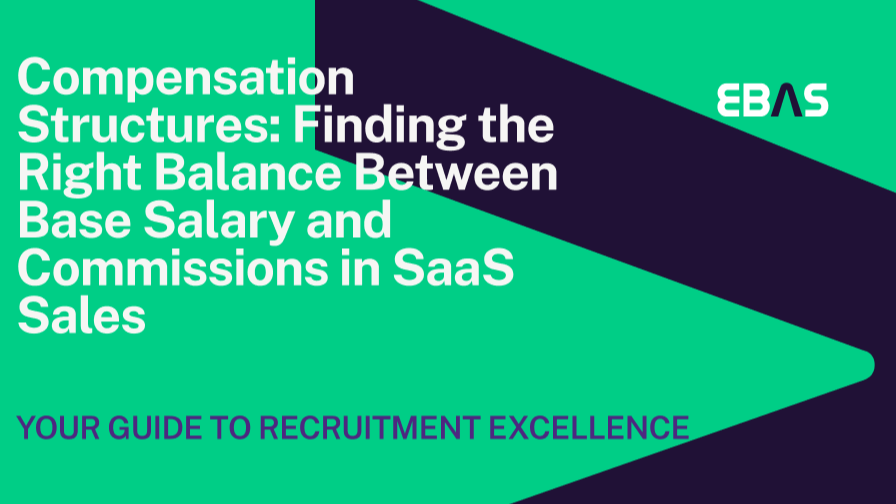Compensation Structures: Finding the Right Balance Between Base Salary and Commissions in SaaS Sales

Compensation Structures: Finding the Right Balance Between Base Salary and Commissions in SaaS Sales
Hiring top sales talent in the SaaS world has always been a challenge, but today, rising costs are making it even more difficult. Add to that the ongoing debate over compensation models—particularly the balance between base salary and commissions—and it’s clear that companies are grappling with a big question: What’s the right compensation structure to attract and retain high-performing salespeople?
Some believe that high-commission structures drive performance, motivating reps to close more deals and hit aggressive targets. Others argue that too much focus on commissions can lead to burnout, unethical practices, or an overly competitive culture that hurts collaboration and long-term growth.
As sales leaders, business owners, or recruiters, the way we approach compensation can have a lasting impact on team dynamics, employee satisfaction, and, of course, revenue. Let’s dive into the key challenges, risks, and opportunities associated with different compensation structures—and what it all means for your SaaS sales team.

The Rising Cost of Hiring Top Sales Talent
The cost of hiring top-tier sales talent has surged in recent years. With the explosion of the SaaS industry, experienced sales professionals are in high demand, and they’re commanding premium compensation packages. But with higher costs comes greater scrutiny—especially around what’s driving those costs.
For many companies, the real question isn’t just how much they should be paying their sales teams, but how that compensation is structured. A well-designed compensation model can help you attract top talent, but an imbalanced one could result in poor performance, high turnover, or even damage to your company’s reputation.
The Two Main Models
- Base Salary + Commission: This is the most common structure in SaaS sales. It offers a balance between financial stability and performance-based rewards.
- High-Commission, Low-Base Salary: This approach is designed to push reps to maximize sales, with the majority of their earnings tied to their success.
Each model has its pros and cons, but the debate around these structures often centers on finding the right balance between motivating high performance and avoiding burnout or unethical behavior.

Pro Tip #1: Evaluate your competitors’ compensation structures when designing your own. This will help you remain competitive in attracting top talent while also ensuring your model is sustainable long-term.
The Argument for Aggressive Commission Structures
In high-growth SaaS companies, speed and performance matter. Aggressive commission structures reward sales reps who consistently hit their numbers and close big deals. For companies scaling rapidly, this type of compensation model can fuel growth by pushing reps to go after high-value clients and more ambitious sales goals.
Here’s why some leaders swear by high-commission structures:
- Motivation: With a large portion of their earnings tied to performance, salespeople have a direct financial incentive to exceed quotas.
- Focus on Results: Commission-driven compensation ensures that reps are focused on closing deals, and improving overall revenue.
- Scalability: As revenue grows, so do commissions, making it a scalable compensation model for businesses in hyper-growth mode.
However, aggressive commission structures can come with their own set of challenges. While some salespeople thrive under pressure, others may struggle with the stress or resort to cutting corners, which can lead to ethical concerns.

Pro Tip #2: When using high-commission models, ensure that quotas are realistic and that the path to success is clear. Providing sales enablement tools and ongoing training can help reps thrive in this environment without resorting to shortcuts.
The Risks of Burnout and Unethical Behavior
While commissions can be a great motivator, they can also lead to serious issues if not managed properly.
- Burnout: Sales reps who are constantly chasing aggressive targets may push themselves too hard. Over time, this leads to burnout, lower productivity, and higher turnover rates. If the compensation model is too commission-heavy, reps may feel like they’re in a “sink or swim” scenario with no financial safety net.
- Unethical Behavior: In some cases, the drive to hit numbers can lead to unethical behaviour. This could include misleading clients, overselling the product’s capabilities, or rushing customers through the buying process. Not only can this hurt the company’s reputation, but it can also lead to customer churn and long-term damage to client relationships.
- Lack of Collaboration: An overly aggressive commission structure can foster a “me-first” culture where collaboration takes a back seat. Salespeople may be less likely to share leads or collaborate on complex deals, which can hurt overall team performance.

Pro Tip #3: Create a balanced scorecard that rewards not just deal closings, but other important behaviors like collaboration, customer satisfaction, and long-term relationship building. This can mitigate some of the risks of aggressive commission structures.
The Case for a Balanced Compensation Model
Many sales leaders believe that the best approach is a balanced compensation model—one that offers both a fair base salary and a meaningful, yet not overwhelming, commission structure. Here’s why:
- Security + Motivation: Reps feel financially secure with a stable base salary, which can reduce stress and burnout. At the same time, the commission piece provides motivation to drive performance.
- Long-Term Thinking: With less pressure to hit immediate targets, reps may be more inclined to build long-term relationships with clients, leading to higher customer lifetime value and lower churn.
- Better Collaboration: A balanced model encourages teamwork and collaboration since reps don’t feel like they’re fighting solely for their own paycheck. This can foster a healthier team culture, which in turn leads to better performance overall.
While this approach may not push reps to work as aggressively as a high-commission model, it tends to promote sustainability, loyalty, and long-term growth—especially important in industries like SaaS, where relationship-building and ongoing client engagement are key.

Pro Tip #4: Consider tiered commission structures, where the more a rep sells, the higher the percentage of commission they earn. This can strike a balance between motivating performance and offering financial security.
Aligning Compensation with Company Goals
At the end of the day, your compensation structure should align with your company’s overall goals and culture. In SaaS sales, you’re not just looking for reps who can close deals—you’re looking for people who can foster relationships, understand complex buying cycles, and contribute to long-term growth.
If your company values collaboration, long-term relationships, and sustainability, a balanced compensation model may be the better choice. If you’re in hyper-growth mode and need aggressive performance to hit ambitious targets, a higher-commission model might be more appropriate.
The key is to strike the right balance—offering enough incentive for high performance, without sacrificing the well-being of your team or the integrity of your sales process.

Pro Tip #5: Regularly review your compensation structure as your company grows. What works for a startup in early growth may not work as you scale, so stay agile and be willing to adapt to changing needs.
Final Thoughts: Compensation Is About More Than Money
Ultimately, compensation in SaaS sales isn’t just about money—it’s about motivation, sustainability, and culture. A well-designed compensation structure can motivate your team, align their goals with the company’s, and create a positive work environment where reps feel valued and rewarded for their efforts.
But it’s important to remember that no one-size-fits-all model exists. The right compensation structure will depend on your company’s growth stage, goals, and the type of sales environment you want to foster.
By finding the right balance between base salary and commission, and regularly reviewing how that structure is impacting both performance and culture, you can ensure your SaaS sales team remains motivated, engaged, and ready to drive your company’s success.
How EBAS Can Help You Hire Smarter At the end of the day, the right compensation model needs to fit both your company’s goals and the sales talent you’re bringing on board. EBAS specializes in helping SaaS companies not only hire fast but also hire the right people with compensation packages that drive long-term success.
Let’s talk about how EBAS can help you design a compensation strategy that works for your business.

Read Next
Learn the top habits for sales success. From active listening to time management, discover how to boost your sales skills and close more deals.
Discover key strategies for hiring tech sales professionals, from asking the right questions to fostering a relaxed interview atmosphere.
Explore the future of hiring with The EBAS Hiring Edge — expert insights on recruitment trends, talent strategies, and employer branding for 2024 and beyond.
Hire Top Sales Talent in 21 Days—On Track to Hit Your Targets in 90 Days
Discuss next steps to start recruiting.